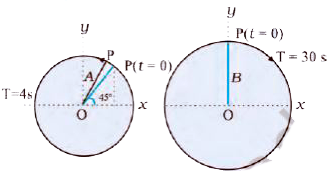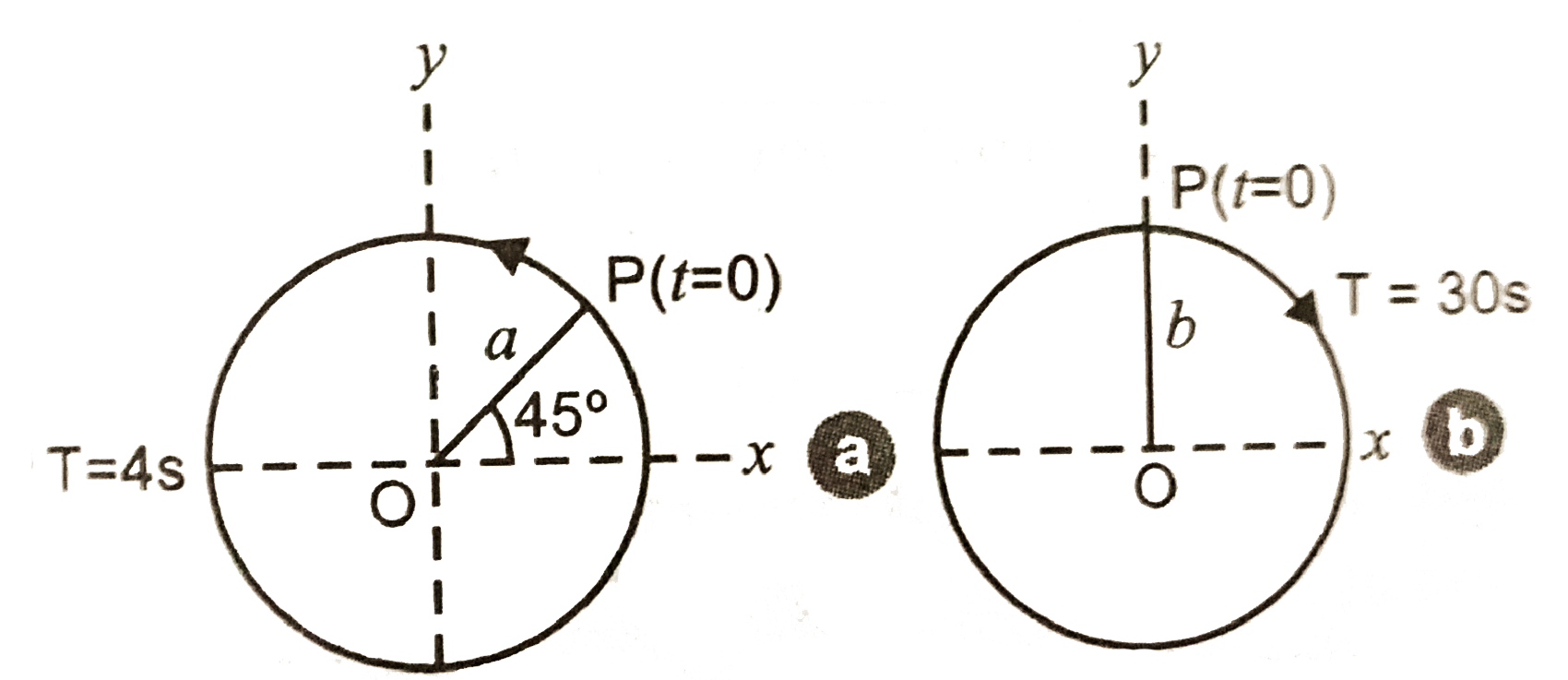The figure given below depicts two circular motions. The radius of the circle, the period of revolution, the initial position and the sense of revolution are indicated in the figures. Obtain the simple harmonic motions of the x-projection of the radius vector of the rotating particle P in each case.
 Solution in Bengali
Solution in Bengali
(a) At t = 0, OP makes an angle of 45∘=π/4 rad with the (positive direction of ) x-axis. After time t, it covers an angle 2πTt in the anticlockwise sense, and makes an angle of 2πTt+π4 with the x-axis.
The projection of OP on the x-axis at time t is given by,
x(t)=Acos(2πTt+π4)
For T=4s.
x(t)=Acos(2π4t+π4)
which is a SHM of amplitude A, period 4 s,
and an initial phase*=π4.
(b) In this case at t = 0, OP makes an angle of 90∘=π2 with the x-axis. After a time t, it covers an angle of 2πTt in the clockwise sense and makes an angle of (π2−2πTt) with the x-axis. The projection of OP on the x-axis at time t is given by
x(t)=Bcos(π2−2πTt)
=Bsin(2πTt)
For T = 30 s,
x(t)=Bsin(π15t)
Writing this as x (t ) = B cos(π15t−π2), and comparing with Eq. (14.4). We find that this represents a SHM of amplitude B, period 30 s, and an initial phase of −π2.
Topper's Solved these Questions
- OSCILLATIONSBook:NCERT BANGLISHChapter:OSCILLATIONSExercise:Exercises
Explore 27 Videos
- OSCILLATIONSBook:NCERT BANGLISHChapter:OSCILLATIONSExercise:Additional Exercises
Explore 6 Videos
- MOTION IN A STRAIGHT LINEBook:NCERT BANGLISHChapter:MOTION IN A STRAIGHT LINEExercise:ADDITIONAL EXERCISES
Explore 5 Videos
- SYSTEMS OF PARTICLES AND ROTATIONAL MOTIONBook:NCERT BANGLISHChapter:SYSTEMS OF PARTICLES AND ROTATIONAL MOTIONExercise:EXERCISES (TRUE OR FALSE)
Explore 3 Videos
Similar Questions
Which of the following examples represent periodic motion?
View SolutionAn air chamber of volume V has a neck area of cross section a into which a ball of mass m just fits and can move up and down without any friction (Fig.14.27). Show that when the ball is pressed down a little and released , it executes SHM. Obtain an expression for the time period of oscillations assuming pressure-volume variations of air to be isothermal [see Fig. 14.27].

View SolutionA boy standing on a stationary lift (open from above) throws a ball upwards with the maximum initial speed he can, equal to 49ms−1. How much time does the ball take to return to his hands ? If the lift starts moving up with a uniform speed of 5ms−1 and the boy again throws the ball up with the maximum speed he can, how long does the ball take to return to his hands ?
View SolutionThe instantaneous speed of the point of contact during rolling is zero.
View Solutiondepict two circulat mothions. The radius of the circle, the period of revolution, the initial position and sense of revolution are indicated in the figures. Obtain the simple harmonic motinosof the x-projection of the radius vector of the rotating particle P in each case.

View Solutionthe circular motion of a particle. The radius of the circle, the period, sense of revolution and the initial position are indicated on the figure. The simple harmonic motion of the x-projection of the radius vector of the rotating particle P is

View SolutionFigure shows the circular motion of a particle. The radius of the circle, the period, same of revolution and the initial position are indicated on the figure. The simple harmonic motion of the x-projection of the radius vector the rotating particle P is
View Solution
Figure depicts two circular motions. The radius of the circle, the period of revolution, the initial position and the sense of revolution are indicated on the figure. Obtain the SHMs of the x-projection of the radius vector of the rotating particle P in each case.
View SolutionFigure shows the circular motion of a particle. The radius of the circle, the period, sense of revolution and the initial position are indicated in the · figure. The simple harmonic motion of the X-projection of the radius vector of the rotating particle Pis
View SolutionFigure shows the circular motion of a particle. The radius of the circle, the period, sense of revolution and the initial positionn are indicated in the figure. The simple harmonic motion off the x-projection of the radius vector of the rotating particle P is
View SolutionFigure below correspond to two circular motions. The radius of the circle, the period of revolution, the initial position, and the sense of revolution (i.e. clockwise or anticlockwise) are indicated on each figure. Obtain the corresponding simple harmonic motions of the x-projection of the radius vector of the revolving particle P in each case.

View SolutionFigures 14.25 correspond to two circular motions. The radius of the circle, the period of revolution, the initial position, and the sense of revolution (i.e. clockwise or anti-clockwise) are indicated on each figure.

Obtain the corresponding simple harmonic motions of the x-projection of the radius vector of the revolving particle P, in each case.
View SolutionFigures depicts two circular motions. The radius of the circle, the period of revolution, the initial position and the sense of revolution are indicated on the figures. Obtain the simple harmonic motions of the x-projection of the radius vector of the rotating particle P in each case.

View SolutionFigures depicts two circular motions. The radius of the circle, the period of revolution, the initial position and the sense of revolution are indicated on the figures. Obtain the simple harmonic motions of the x-projection of the radius vector of the rotating particle P in each case.

View SolutionFigure shows the circular motion of a particle. The radius of the circle, the period, sense of revolution and the initial position are indicated on the figure. The simple harmonic motion of the x-projection of the radius vector of the rotating particle P is..........
View Solution